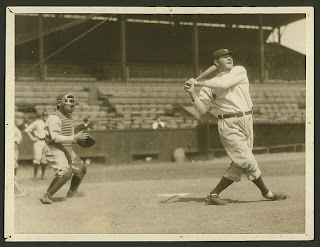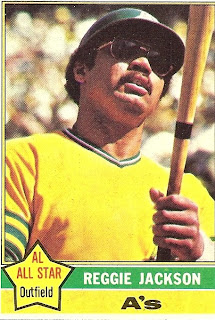Two great players have worn either 0 or 00 - Al Oliver and Jack Clark, respectively.
"I went three days without a hit and my wife refused to cook me dinner. When I didn't get a hit the fourth day, she gave her tickets away. I guess if I ever go a week witho
 ut a hit, I'll be sleeping in a tent in the backyard." - Al Oliver
ut a hit, I'll be sleeping in a tent in the backyard." - Al OliverOliver wore number 0 while with the Montreal Expos, with whom he played from 1982-83, but his career spanned from 1968 through 1985. One of the premier hitters of his era, Oliver had 2,743 career hits (45th best all time) and a .303 average over 18 major league seasons. He played in seven All-Star games and placed among his league's top 10 batters on nine occasions. He was a member of the 1971 World Champ Pittsburgh Pirates. Oliver hit the last home run ever at Forbes Field, and the next season, drove in the first run ever at Three Rivers Stadium. He is pictured here on his 1983 card from my collection.
 itting 25 homers and 62 RBIs in 334 at-bats. Over his 18-year career Clark hit 340 homers with 1,180 RBIs. ''It's distinctive. It's fresh, not your basic number,'' Clark said in 1990 when asked why he shifted from No. 25. ''It's your basic non-number." Clark was a four time All Star and hit 340 homers over his career. This is a scan of his 1978 card when he was with the Giants, where he played from 1975 through 1984.
itting 25 homers and 62 RBIs in 334 at-bats. Over his 18-year career Clark hit 340 homers with 1,180 RBIs. ''It's distinctive. It's fresh, not your basic number,'' Clark said in 1990 when asked why he shifted from No. 25. ''It's your basic non-number." Clark was a four time All Star and hit 340 homers over his career. This is a scan of his 1978 card when he was with the Giants, where he played from 1975 through 1984. hy is he included in today's blog? While he did not wear number 0, he's included because his lifetime little league batting average was WELL south of the Mendoza Line, and probably closer to 0 than anything else!
hy is he included in today's blog? While he did not wear number 0, he's included because his lifetime little league batting average was WELL south of the Mendoza Line, and probably closer to 0 than anything else!Now, in memory of sportscaster George Michael, who was the inventor of "George Michael's Sports Machine" and a long time DC sportscaster who passed away yesterday morning after a two year battle with leukemia.










 In 1939 he was named player-manager of the Brooklyn Dodgers, where he stayed (off and on, after many overnight firings and subsequent morning hirings by GM Larry MacPhail. He moved to the Giants in 1948 where he stayed through 1955. His managerial record was 2008-1709, and he won 4 World Series. He still ranks fourth on the all time list for most ejections by a manager. Durocher was elected to the Hall of Fame in 1994.
In 1939 he was named player-manager of the Brooklyn Dodgers, where he stayed (off and on, after many overnight firings and subsequent morning hirings by GM Larry MacPhail. He moved to the Giants in 1948 where he stayed through 1955. His managerial record was 2008-1709, and he won 4 World Series. He still ranks fourth on the all time list for most ejections by a manager. Durocher was elected to the Hall of Fame in 1994.
 George Herman Ruth wore number 3 for the New York Yankees. (Note to Red Sox fans, I would love to give him credit for wearing number 3 for Boston, but alas, in his final season in Beantown (1919) the Red Sox, as most teams, were not displaying numbers on jerseys.) This hot dog eating, cigar smoking, reform school graduate, son of a Baltimore bartender, who never grew up and suffered from "The Bellyache Heard 'Round The World" became the most feared hitter ever in major league baseball. For the novices who read my blog, Babe was also a VERY accomplished pitcher before playing full time in the outfield.
George Herman Ruth wore number 3 for the New York Yankees. (Note to Red Sox fans, I would love to give him credit for wearing number 3 for Boston, but alas, in his final season in Beantown (1919) the Red Sox, as most teams, were not displaying numbers on jerseys.) This hot dog eating, cigar smoking, reform school graduate, son of a Baltimore bartender, who never grew up and suffered from "The Bellyache Heard 'Round The World" became the most feared hitter ever in major league baseball. For the novices who read my blog, Babe was also a VERY accomplished pitcher before playing full time in the outfield. 













 17. While playing off and on for the Mets between 1962 and 1964, he was called up "for good" (he did have another stint in the minors) in 1965 and changed his number to the infamous number 7. That was the first of many breakout years for Kranepool, as he was selected to the NL All Star team. By 1969, Kranepool was one of the leaders of the team and helped lead the Metropolitans to a World Series title. Kranepool even had a home run in that fall classic. After spending part of the 1970 season in the minors, Kranepool bounced back in 1971 to hit 14 home runs and lead the league with a .998 fielding percentage. Late in his career, he was relegated to platooning at first base, then later as a feared pinch hitter. In fact, his .486 as a pinch hitter in 1974 still stands as a single season major league record! Kranepool retired at the end of the 1978 season, and at the time of his retirement, he held eight team records, of which he still holds four. Kranepool is the team leader in at bats, hits, doubles, and stolen bases. He also played more games for the Mets than any other player, and was the last player from the original 1962 Mets to retire.
17. While playing off and on for the Mets between 1962 and 1964, he was called up "for good" (he did have another stint in the minors) in 1965 and changed his number to the infamous number 7. That was the first of many breakout years for Kranepool, as he was selected to the NL All Star team. By 1969, Kranepool was one of the leaders of the team and helped lead the Metropolitans to a World Series title. Kranepool even had a home run in that fall classic. After spending part of the 1970 season in the minors, Kranepool bounced back in 1971 to hit 14 home runs and lead the league with a .998 fielding percentage. Late in his career, he was relegated to platooning at first base, then later as a feared pinch hitter. In fact, his .486 as a pinch hitter in 1974 still stands as a single season major league record! Kranepool retired at the end of the 1978 season, and at the time of his retirement, he held eight team records, of which he still holds four. Kranepool is the team leader in at bats, hits, doubles, and stolen bases. He also played more games for the Mets than any other player, and was the last player from the original 1962 Mets to retire.  asking if I had heard of him because under employer, Kranepool wrote "New York Mets." He gave an autographed baseball to my mother for me, and also passed along a batting tip (to open up my stance) that helped a struggling little leaguer with a bad eye (literally and figuratively). When Kranepool returned to NY, he sent me a personalized autographed 8x10 glossy photo from his home address. The next spring, my buddy Dave and I attended the Mets-Dodgers game at Al Lang Stadium. We made posters and brought baseballs, and Ed graciously signed both. Later, in high school, we formed the Ed Kranepool Fan Club, and my buddy Jim and I would type up newsletters during typing class!
asking if I had heard of him because under employer, Kranepool wrote "New York Mets." He gave an autographed baseball to my mother for me, and also passed along a batting tip (to open up my stance) that helped a struggling little leaguer with a bad eye (literally and figuratively). When Kranepool returned to NY, he sent me a personalized autographed 8x10 glossy photo from his home address. The next spring, my buddy Dave and I attended the Mets-Dodgers game at Al Lang Stadium. We made posters and brought baseballs, and Ed graciously signed both. Later, in high school, we formed the Ed Kranepool Fan Club, and my buddy Jim and I would type up newsletters during typing class!















 The naming of Rose in the Countdown certainly is a controversial decision. Many people remember Rose the player, while others remember Rose the banned. I lean more on the side of remembering him as a player, and I believe he has served a long enough sentence. Besides owning 17 major league records as a player, as well as seven other National League records, Charlie Hustle was known for his
The naming of Rose in the Countdown certainly is a controversial decision. Many people remember Rose the player, while others remember Rose the banned. I lean more on the side of remembering him as a player, and I believe he has served a long enough sentence. Besides owning 17 major league records as a player, as well as seven other National League records, Charlie Hustle was known for his 




